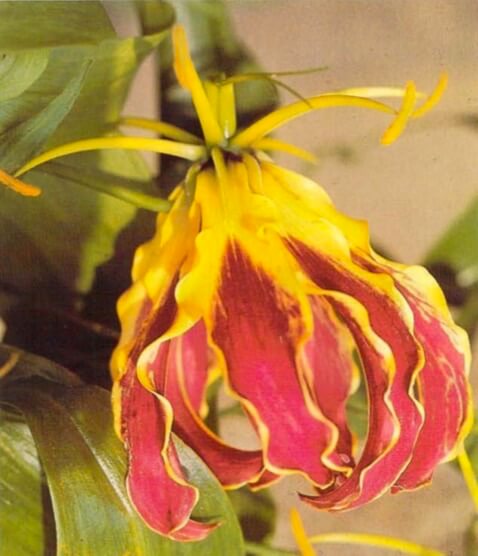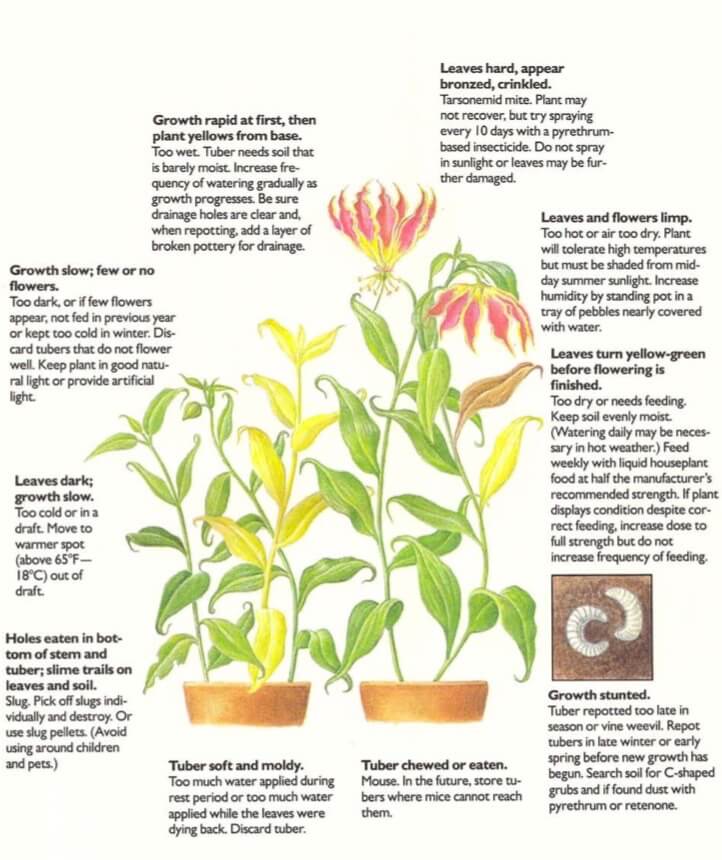[Ebook Việt Hoá] The Instant Guide to Healthy Houseplants (Hướng dẫn tức thời để chăm cây trong nhà khoẻ mạnh), Chi Gloriosa
[Ebook Việt Hoá] The Instant Guide to Healthy Houseplants: Gloriosa superba (Mozambique lily, Glory lily)
- Nguồn: [Ebook Việt Hoá] The Instant Guide to Healthy Houseplants (Hướng dẫn tức thời để chăm cây trong nhà khoẻ mạnh)
- Biên tập: Dũng Cá Xinh
- Biên dịch: Team Codai.net
English
Mozambique lily, sometimes called glory lily, is a native of the rain forests of tropical Africa. It is very tender and needs warmth, high humidity and bright light for best growth and to produce its magnificent red and yellow flowers. Plants may be grown from tubers potted up in late winter or early spring or purchased already growing in pots. Tubers can be repotted each year for 3-5 years.

Light
Needs bright light year-round but must be shaded from direct midday sunlight on hottest days.
Temperature
At the beginning of the growing season, maintain a temperature of 60-65°F(16-18°C). Established plants will tolerate temperatures as high as 8soF (29°C). Rest tubers at 50-55°F (10-13°C).
Water
Keep soil evenly moist until growth is strong, then gradually increase amount of water given at each watering. While plant is in flower and weather is hot, water daily. Decrease frequency of watering in fall and keep dry during winter rest period.
Humidity
Maintain high humidity by standing pot in saucer filled with wet pebbles. Mist around plant but do not mist flowers.
Feeding
When plant is 12 in (30 cm) tall, begin feeding weekly with liquid houseplant food at half the manufacturer’s recommended strength. Continue feeding until foliage dies.
Soil
Use soilless mix.
After flowering
Remove dead flower heads and decrease frequency of watering. (Allow soil surface to dry out between waterings.) When foliage and stems have withered, cut back plant to soil level. Place pot on its side in a dark, cool spot (50-55°F – 10-13°C). Do not water.
Propagation
Tubers can be repotted each year for 3-5 years. Pot them individually 2 in (5 cm) deep in 6-in (15-cm) pots. Keep in a bright spot. In late winter or early spring, lift tubers, separate offsets and repot for another growing season. (Put a layer of broken pottery in bottom of pot for drainage.) Off-sets will flower after 2 years if fed regularly during the growing season.
Support
Mozambique lilies grow up to 6 ft (2 m) in a season, so they need support. When adding a stake but not repotting, take care not to damage stems and leaves and not to disturb bulb and roots. When repotting, position support at least I in (2.5 cm) from tuber.

What Goes Wrong

- Growth rapid at first, then plant yellows from base: Too wet. Tuber needs soil that is barely moist. Increase frequency of watering gradually as growth progresses. Be sure drainage holes are clear and, when repotting, add a layer of broken pottery for drainage.
- Growth slow; few or no flowers: Too dark, or if few flowers appear, not fed in previous year or kept too cold in winter. Discard tubers that do not flower well. Keep plant in good naturallight or provide artificial light.
- Leaves hard, appear bronzed, crinkled: Tarsonemid mite. Plant may not recover, but try spraying every 10 days with a pyrethrum- based insecticide. Do not spray in sunlight or leaves may be further damaged.
- Leaves dark; growth slow. Too cold or in a draft. Move to warmer spot (above 65° F- 18°C) out of draft.
- Holes eaten in bot- tom of stem and tuber; slime trails on leaves and soil: Slug. Pick off slugs individually and destroy. Or use slug pellets. (Avoid using around children and pets.)
- Tuber soft and moldy: Too much water applied during rest period or too much water applied while the leaves were dying back. Discard tuber.
- Tuber chewed or eaten: Mouse. In the future, store tubers where mice cannot reach them.
- Leaves and flowers limp: Too hot or air too dry. Plant will tolerate high temperatures but must be shaded from mid- day summer sunlight. Increase humidity by standing pot in a tray of pebbles nearly covered with water.
- Leaves turn yellow-green before flowering is finished: Too dry or needs feeding. Keep soil evenly moist. (Watering daily may be necessary in hot weather.) Feed weekly with liquid houseplant food at half the manufacturer’s recommended strength. If plant displays condition despite correct feeding, increase dose to full strength but do not increase frequency of feeding.
- Growth stunted: Tuber repotted too late in season or vine weevil. Repot tubers in late winter or early spring before new growth has begun. Search soil for C-shaped grubs and if found dust with pyrethrum or retenone.
Tiếng Việt
Hoa Ly lửa, đôi khi được gọi là hoa ly rực rỡ, là loài bản địa của các khu rừng mưa nhiệt đới Châu Phi. Nó rất nhạy cảm cần sự ấm áp, độ ẩm cao với ánh sáng rực rỡ để phát triển tốt nhất và cho ra những bông hoa màu vàng và đỏ tuyệt đẹp. Cây có thể được trồng từ củ trong chậu vào cuối mùa đông hoặc đầu mùa xuân hay mua về trồng trong chậu. Củ nên được thay chậu mỗi năm trong vòng 3 – 5 năm.

Ánh sáng
Cần ánh sáng quanh năm nhưng phải che nắng trực tiếp giữa trưa vào những ngày nắng nóng nhất.
Nhiệt độ
Vào đầu mùa sinh trưởng, duy trì nhiệt độ 60 – 65 ° F (16 – 18 ° C). Cây sẽ chịu được nhiệt độ cao tới 84 ° F (29 ° C). Để củ ở 50 – 55 ° F (10 – 13 ° C).
Nước
Giữ ẩm đều cho đất cho đến khi cây phát triển mạnh, sau đó tăng dần lượng nước cho mỗi lần tưới. Khi cây đang ra hoa và thời tiết nắng nóng, tưới nước hàng ngày. Giảm tần suất tưới vào mùa thu và giữ khô ráo trong thời gian nghỉ đông.
Độ ẩm
Duy trì độ ẩm cao bằng cách đặt chậu trong đĩa đầy sỏi ướt. Phun sương xung quanh cây nhưng không phun sương cho hoa.
Bón phân
Khi cây cao 12 inch (30 cm), hãy bắt đầu bón phân hàng tuần với phân bón hữu cơ dạng lỏng với một nửa cường độ khuyến nghị của nhà sản xuất. Tiếp tục bón phân cho đến khi tàn lá.
Đất
Sử dụng hỗn hợp không cần đất.
Sau khi ra hoa
Loại bỏ các đầu hoa chết và giảm tần suất tưới nước. (Để cho bề mặt đất khô đi giữa các lần tưới.) Khi tán lá và thân cây đã héo, hãy cắt phần cây trên mặt đất. Đặt chậu nằm nghiêng ở nơi mát mẻ, tối thiểu (50 – 55 ° F – 10 – 13 ° C). Không tưới nước.
Nhân giống
Củ có thể được thay chậu mỗi năm trong vòng 3-5 năm. Đặt chúng sâu 2 inch (5 cm) trong các chậu 6 inch (15 cm). Giữ ở một nơi sáng. Vào cuối mùa đông hoặc đầu mùa xuân, nhấc củ, tách các nhánh và thay chậu cho một mùa sinh trưởng khác. (Đặt một lớp gốm vỡ dưới đáy chậu để thoát nước.) Các cây con sẽ ra hoa sau 2 năm nếu được bón phân thường xuyên trong mùa sinh trưởng.
Vật chống đỡ
Hoa Ly lửa phát triển lên đến 6 ft (2 m) trong một mùa, vì vậy chúng cần được chống đỡ. Khi cắm thêm cọc nhưng không thay chậu, chú ý không làm tổn thương thân, lá và không làm xáo trộn củ và rễ. Khi thay chậu, đặt giá đỡ cách củ ít nhất 1 inch (2,5 cm).

Những vấn đề có thể xảy ra

- Lúc đầu cây phát triển nhanh, sau đó cây bị vàng từ gốc: Quá ẩm ướt. Củ cần đất ít ẩm. Tăng tần suất tưới nước dần dần khi cây phát triển. Đảm bảo lỗ thoát nước thông thoáng và khi thay chậu, hãy phủ thêm một lớp gốm vỡ để thoát nước.
- Tăng trưởng chậm; ít hoặc không có hoa: Quá tối, hoặc nếu ít hoa xuất hiện, không được bón phân trong năm trước hoặc quá lạnh trong mùa đông. Bỏ những củ không ra hoa. Đặt cây trong ánh sáng tự nhiên tốt hoặc cung cấp ánh sáng nhân tạo.
- Lá cứng, có màu vàng, nhăn nheo: Mạt nhện trắng. Cây có thể không phục hồi, nhưng hãy thử phun thuốc trừ sâu pyrethrum 10 ngày một lần. Không phun dưới ánh sáng mặt trời nếu không lá có thể bị hỏng thêm.
- Lá sẫm màu; tăng trưởng chậm: Quá lạnh hoặc gió lùa mạnh. Di chuyển đến chỗ ấm hơn (trên 65 ° F- 18 ° C) và tránh gió lùa.
- Các vết ở đáy thân và củ bị ăn; các vệt chất nhờn trên lá và đất: Sên. Nhặt từng con sên và loại bỏ. Hoặc sử dụng viên nén sên. (Tránh sử dụng xung quanh trẻ em và vật nuôi.)
- Củ mềm và bị mốc: Tưới quá nhiều nước trong thời gian cây nghỉ hoặc quá nhiều nước khi lá đang chết trở lại. Bỏ củ.
- Củ nhão hoặc bị ăn: Chuột. Thời gian tới, hãy cất giữ củ ở nơi chuột không thể tiếp cận.
- Lá và hoa mềm nhũn: Quá nóng hoặc không khí quá khô. Cây chịu được nhiệt độ cao nhưng phải che nắng giữa ngày hè. Tăng độ ẩm bằng cách đặt chậu cây trong khay đá cuội gần ngập nước.
- Lá chuyển sang màu xanh vàng trước khi kết thúc ra hoa: Quá khô hoặc cần bón phân. Giữ ẩm đều cho đất. (Có thể tưới nước hàng ngày khi thời tiết nóng.) Hàng tuần sử dụng phân bón hữu cơ dạng lỏng với liều lượng bằng một nửa khuyến cáo của nhà sản xuất. Nếu cây có biểu hiện bệnh mặc dù đã bón phân đúng cách, hãy tăng liều lượng đến mức tối đa nhưng không tăng tần suất bón.
- Sinh trưởng còi cọc: Củ thay chậu quá muộn trong mùa hoặc bị mọt nho. Thay củ vào cuối mùa đông hoặc đầu mùa xuân trước khi bắt đầu phát triển mới. Tìm trong đất những con côn trùng hình chữ C và nếu tìm thấy hãy rắc pyrethrum hoặc retenone lên.
![[Ebook Việt Hoá] The Instant Guide to Healthy Houseplants: Gloriosa superba (Mozambique lily, Glory lily) [Ebook Việt Hoá] The Instant Guide to Healthy Houseplants: Gloriosa superba (Mozambique lily, Glory lily)](https://vn1.vdrive.vn/codai.net/2020/02/ebook-huong-dan-tuc-thoi-cham-cay-trong-nha-khoe-manh-68-gloriosa-superba.jpg)


